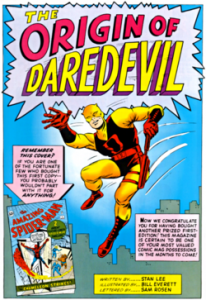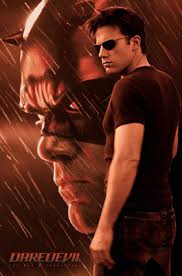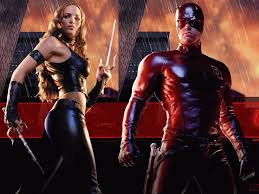Daredevil (Marvel Comics)
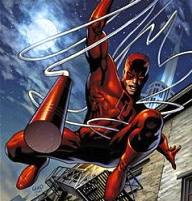
Daredevil Reborn – The Mothion Comic – Chapter One (Fan-Made) (HD)
The apocalyptic events of SHADOWLAND have left the once-proud legacy of Daredevil in tatters. Now, far from the mean streets of Hell’s Kitchen, a new evil is rising, and the only man crazy enough to face it is a man with nothing left to lose. The road to Hell was paved with good intentions, but the long road to redemption is the far harder path. First in a new series of fan-made motion comic videos, from the Marvel Comics series, featuring a fully dramatised vocal enactment by myself and completely enhanced with music and sound effects.
 Promotional art for Daredevil vol. 2, #65 (Sept. 2004), by Greg Land.
Promotional art for Daredevil vol. 2, #65 (Sept. 2004), by Greg Land.
Daredevil is a fictional character, a superhero that appears in comic bookspublished by Marvel Comics. The character was created by writer–editor Stan Leeand artist Bill Everett, with an unspecified amount of input from Jack Kirby, and first appeared in Daredevil #1 (April 1964).
Living in the Hell’s Kitchen neighborhood of New York City, Matt Murdock is blinded by a radioactive substance that falls from an oncoming vehicle. While he no longer can see, the radioactive exposure heightens his remaining senses beyond normal human ability. His father, a boxer named Jack Murdock, supports him as he grows up, though Jack is later killed by gangsters after refusing to throw a fight. After donning a yellow and black, and later a dark red, costume, Matt seeks out revenge against his father’s killers as the superhero Daredevil, fighting against his many enemies including Bullseye and the Kingpin. Daredevil’s nickname is “the Man Without Fear.”
Although Daredevil had been home to the work of comic-book artists such as Everett, Kirby, Wally Wood, John Romita, Sr., and Gene Colan, among others. Frank Miller‘s influential tenure on the title in the early 1980’s cemented the character as a popular and influential part of the Marvel Universe. Daredevil has since appeared in many various forms of media including several animated series, video games, merchandise, and a 2003 feature-length film.
The character debuted in Marvel Comics‘ Daredevil #1 (cover date April 1964), created by writer-editor Stan Lee and artist Bill Everett, with character design input from Jack Kirby, who devised Daredevil’s billy club. When Everett turned in his first-issue pencils extremely late, Marvel production manager Sol Brodsky andSpider-Man co-creator Steve Ditko inked a large variety of different backgrounds, a “lot of backgrounds and secondary figures on the fly and cobbled the cover and the splash page together from Kirby’s original concept drawing.”
Writer and comics historian Mark Evanier has concluded (but cannot confirm) that Kirby designed the basic image of Daredevil’s costume, though Everett modified it. The character’s original costume design was a combination of black, yellow, and red, reminiscent of acrobat tights. Wally Wood, known for his 1950s EC Comics stories, penciled and inked issues #5-10, introducing Daredevil’s modern red costume in issue #7.
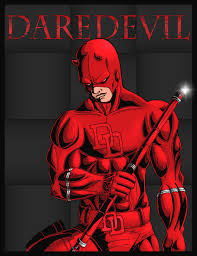 Issue #12 began a brief run by Jack Kirby (layouts) and John Romita, Sr. The issue marked Romita’s return to superhero penciling after a decade of working exclusively as a romance-comic artist for DC. Romita had felt he no longer wanted to pencil, in favor of being solely an inker. He recalled in 1999,
Issue #12 began a brief run by Jack Kirby (layouts) and John Romita, Sr. The issue marked Romita’s return to superhero penciling after a decade of working exclusively as a romance-comic artist for DC. Romita had felt he no longer wanted to pencil, in favor of being solely an inker. He recalled in 1999,
“I had inked an Avengers job for Stan, and I told him I just wanted to ink. I felt like I was burned out as a penciller after eight years of romance work. I didn’t want to pencil any more; in fact, I couldn’t work at home any more — I couldn’t discipline myself to do it. He said, ‘Okay,’ but the first chance he had he shows me this Daredevil story somebody had started and he didn’t like it, and he wanted somebody else to do it.”
Romita later elaborated that,
“Stan showed me Dick Ayers‘ splash page for a Daredevil. He asked me, “What would you do with this page?” I showed him on a tracing paper what I would do, and then he asked me to do a drawing of Daredevil the way I would do it. I did a big drawing of Daredevil … just a big, tracing-paper drawing of Daredevil swinging. And Stan loved it.”
When Romita left to take over The Amazing Spider-Man, Lee gave Daredevil to what would be the character’s first signature artist, Gene Colan, who began with issue #20 (Sept. 1966). Though #20 identifies Colan as a fill-in penciller, Romita’s work load prevented him from returning to the title, and Colan ended up penciling all but three issues through #100 (June 1973), plus the 1967 annual, followed by ten issues sprinkled from 1974–1979. He would return again for an eight-issue run in 1997.
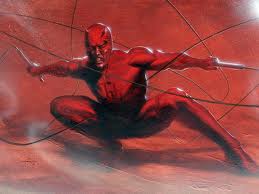 Lee never gave Colan a full script for an issue of Daredevil; instead, he would tell him the plot, and Colan would tape record the conversation to refer to while drawing the issue, leaving Lee to add the script in afterwards. Though Colan is consistently credited as penciler only, Lee would typically give him the freedom to fill in details of the plot as he saw fit. Lee explained “If I would tell Gene who the villain was and what the problem was, how the problem should be resolved and where it would take place, Gene could fill in all the details. Which made it very interesting for me to write because when I got the artwork back and had to put in the copy, I was seeing things that I’d not expected.” The 31-issue Lee/Colan run on the series included Daredevil #47, in which Murdock defends a blind Vietnam veteran against a frameup; Lee has cited it as the story he is most proud of out of his entire career. With issue #51, Lee turned the writing chores over to Roy Thomas (who succeeded him on a number of Marvel’s titles), but would remain on board as editor for another 40 issues.
Lee never gave Colan a full script for an issue of Daredevil; instead, he would tell him the plot, and Colan would tape record the conversation to refer to while drawing the issue, leaving Lee to add the script in afterwards. Though Colan is consistently credited as penciler only, Lee would typically give him the freedom to fill in details of the plot as he saw fit. Lee explained “If I would tell Gene who the villain was and what the problem was, how the problem should be resolved and where it would take place, Gene could fill in all the details. Which made it very interesting for me to write because when I got the artwork back and had to put in the copy, I was seeing things that I’d not expected.” The 31-issue Lee/Colan run on the series included Daredevil #47, in which Murdock defends a blind Vietnam veteran against a frameup; Lee has cited it as the story he is most proud of out of his entire career. With issue #51, Lee turned the writing chores over to Roy Thomas (who succeeded him on a number of Marvel’s titles), but would remain on board as editor for another 40 issues.
The first issue covered both the character’s origins and his desire for justice on the man who had killed his father, boxer “Battling Jack” Murdock, who raised young Matthew Murdock in the Hell’s Kitchen neighborhood of Manhattan, New York City. Jack instills in Matt the importance of education and nonviolence with the aim of seeing his son become a better man than himself. In the course of saving a blind man from the path of an oncoming truck, Matt is blinded by a radioactive substance that falls from the vehicle. The radioactive exposure heightens his remaining senses beyond normal human thresholds, enabling him to detect the shape and location of objects around him. In order to support his son, Jack Murdock returns to boxing under the Fixer, a known gangster, and the only man willing to contract the aging boxer. When he refuses to throw a fight because his son is in the audience, he is killed by one of the Fixer’s men. Adorned in a yellow and black costume made from his father’s boxing robes and using his superhuman abilities, Matt confronts the killers as the superhero Daredevil, unintentionally causing the Fixer to have a fatal heart attack.
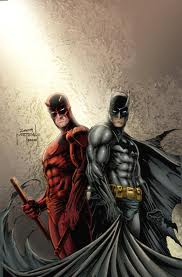 Daredevil would embark on a series of adventures involving such villains as the Owl, Stilt-Man, the Gladiator, and the Enforcers. In issue #16 (May 1966), he meets Spider-Man, a character who would later be one of his greatest hero friends. A letter from Spider-Man unintentionally exposed Daredevil’s secret identity, compelling him to adopt a third identity as his twin brother Mike Murdock, whose carefree, wisecracking personality much more closely resembled that of the Daredevil guise than the stern, studious, and emotionally withdrawn Matt Murdock did. The “Mike Murdock” scheme was used to highlight the character’s quasi-multiple personality disorder (he at one point wonders whether Matt or Mike/Daredevil “is the real me”), but it proved confusing to readers and was dropped in issues #41-42, with Daredevil faking Mike Murdock’s death and claiming he had trained a replacement Daredevil. Murdock reveals his secret identity to his girlfriend Karen Page in issue #57, although she leaves the series after the revelation proves too much for her. This was the first of several long-term breakups between Murdock and Page, who would prove the most enduring of his love interests.
Daredevil would embark on a series of adventures involving such villains as the Owl, Stilt-Man, the Gladiator, and the Enforcers. In issue #16 (May 1966), he meets Spider-Man, a character who would later be one of his greatest hero friends. A letter from Spider-Man unintentionally exposed Daredevil’s secret identity, compelling him to adopt a third identity as his twin brother Mike Murdock, whose carefree, wisecracking personality much more closely resembled that of the Daredevil guise than the stern, studious, and emotionally withdrawn Matt Murdock did. The “Mike Murdock” scheme was used to highlight the character’s quasi-multiple personality disorder (he at one point wonders whether Matt or Mike/Daredevil “is the real me”), but it proved confusing to readers and was dropped in issues #41-42, with Daredevil faking Mike Murdock’s death and claiming he had trained a replacement Daredevil. Murdock reveals his secret identity to his girlfriend Karen Page in issue #57, although she leaves the series after the revelation proves too much for her. This was the first of several long-term breakups between Murdock and Page, who would prove the most enduring of his love interests.
18-year-old Gerry Conway took over as writer with issue #72, and turned the series in a pulp science fiction direction: a lengthy story arc centered on a robot from thousands of years in the future trying to change his timeline, and even long-standing arch-villain the Owl was outfitted with futuristic weaponry and vehicles. Steve Gerber came on board with issue #97, initially scripting over Conway’s plots, but Gene Colan’s long stint as Daredevil’s penciler had come to an end. Gerber recollected, “Gene and I did a few issues together, but Gene was basically trying to move on at that point. He’d just started the Dracula book, and he’d been doingDaredevil for God knows how many years. I think he wanted to do something else.” After six issues with fill-in pencilers, including several with Don Heck, Bob Brown took over as penciller.
Tony Isabella succeeded Gerber as writer, but editor Len Wein disapproved of his take on the series and sent him off after only five issues, planning to write it himself. Instead, he ended up handing both writing and editing jobs to his friend Marv Wolfman with issue #124, which introduced inker Klaus Janson to the title. Wolfman’s 20-issue run included the introduction of one of Daredevil’s most popular villains, Bullseye, and story arc in which the Jester uses computer-generated images to hoodwink the mass media. He was dissatisfied with his work and quit, later explaining, “I felt DD needed something more than I was giving him. I was never very happy with my DD–I never found the thing that made him mine the way Frank Miller did a year or two later. So I was trying to find things to do that interested me and therefore, I hoped, the readers. Ultimately, I couldn’t find anything that made DD unique to me and asked off the title.” His departure coincided with Brown’s death from leukemia.
With issue #144, Jim Shooter became the writer and was joined by a series of short-term pencilers, including Gil Kane, who had been penciling most of Daredevil’s covers since #80 but had never before worked on the comic’s interior. Shooter and artist Carmine Infantino introduced Paladin in issue #150 (Jan. 1978). The series’s once solid sales began dropping during this period, and was downgraded to bi-monthly status with issue #147. Shooter still had difficulty keeping up with the schedule, and the writing chores were shortly turned over to Roger McKenzie.
McKenzie’s work on Daredevil reflected his background in horror comics, and the stories and even the character himself took on a much darker tone: Daredevil battled a personification of death, one of his archenemies was bifurcated by a tombstone, and a re-envisioning of Daredevil’s origin showed him using stalker tactics to drive the Fixer to his fatal heart attack. McKenzie created chain-smoking Daily Bugle reporter Ben Urich, who deduces Daredevil’s secret identity over the course of issues #153-163, and had Daredevil using the criminal underworld of Hell’s Kitchen as an information network, adding several small-time crooks to the supporting cast.
Halfway through his run, McKenzie was joined by penciler Frank Miller, who had previously drawn Daredevil in The Spectacular Spider-Man #27 (Feb. 1979), with issue #158 (May 1979).
Daredevil moved to San Francisco for a time beginning with Daredevil #81 to live with his new love interest, the spy and superheroine the Black Widow. From #92 through #107, the cover logo was retitled Daredevil and the Black Widow. She ends the relationship in issue #124, fearing that playing “sidekick” is sublimating her identity. Murdock returns to Hell’s Kitchen. The lively but emotionally fragile Heather Glenn almost immediately replaced the Black Widow as his love interest. In a story arc overlapping Wolfman, Shooter, and McKenzie’s runs on the series, Daredevil reveals his identity to Glenn and becomes partially responsible for the suicide of her father; their relationship would persist, but would prove increasingly harmful to both of them. Though the Black Widow returned for a dozen issues (#155-166) and attempted to rekindle her romance with Daredevil, he ultimately rejects her in favor of Glenn.
Sales had been declining since the end of the Wolfman/Brown run, and by the time Miller became Daredevil’s penciler, the series was in danger of cancellation. Nor did Miller see himself as the series’s potential savior; he disliked Roger McKenzie’s scripts, and Jim Shooter (who had since become Marvel’s editor-in-chief) had to talk him out of quitting. Seeking to appease Miller, and impressed by a short backup feature he had written, new editor Denny O’Neil fired McKenzie so that Miller could write the series. The decision was made so abruptly that the last issue of McKenzie’s run plugs a two-part story which never appeared though part one eventually saw print in Daredevil #183.
Wally Wood, following kidney failure and the loss of vision in one eye, returned to the character he helped define, inking Miller’s cover of Daredevil #164 (May 1980). It was one of Wood’s final assignments before his death in 1981.
Miller continued the title in a similar vein to McKenzie. Resuming the drastic metamorphosis the previous writer had begun, Miller took the step of essentially ignoring all of Daredevil’s continuity prior to his run on the series; on the occasions where older villains and supporting cast were used, their characterizations and history with Daredevil were reworked or overwritten. Most prominently, dedicated and loving father Jack Murdock was reimagined as a drunkard who physically abused his son Matt, entirely revising Daredevil’s reasons for becoming a lawyer. Spider-Man villain Kingpin was introduced as Daredevil’s new arch-nemesis, displacing most of his large rogues gallery. Daredevil himself was gradually developed into an antihero. In issue #181, he attempts to murder one of his arch-enemies by throwing him off a tall building; when the villain survives as a quadriplegiac, he breaks into his hospital room and tries to scare him to death by playing a two-man variation on Russian roulette with a secretly unloaded gun. Comics historian Les Daniels noted that “Almost immediately, [Miller] began to attract attention with his terse tales of urban crime.” Miller’s revamping of the title was controversial among fans, but it clicked with new readers, and sales began soaring, the comic returning to monthly status just three issues after Miller came on as writer.
Miller introduced ninjas into the Daredevil canon, bringing a martial arts aspect to Daredevil’s fighting skills, and introducing previously unseen characters who had played a major part in his youth: Stick, leader of the ninja clan the Chaste, who had been Murdock’s sensei after he was blinded; a rival clan called the Hand; and Elektra, an ex-girlfriend turned lethal ninja assassin. This was a drastic change for a character once called “the sightless swashbuckler“. Elektra was killed fighting Bullseye in issue #181 (April 1982), an issue which saw brisk sales.
With #185, inker Janson began doing the pencils over Miller’s layouts, and in #191 Miller left the series entirely. O’Neil switched from editor to writer. O’Neil was not enthusiastic about the switch, later saying “I took the gig mostly because there didn’t seem to be (m)any other viable candidates for it.” He continued McKenzie and Miller’s noir take on the series, but backed away from the antihero depiction of the character by having him not only spare Bullseye’s life, but express guilt over his two previous attempts to kill him. Janson left shortly after Miller, replaced initially by penciler William Johnson and inker Danny Bulanadi, who were both supplanted by David Mazzucchelli. Novelists Harlan Ellison and Arthur Byron Cover co-wrote two issues in 1984. Miller returned with a story in issue #219 (June 1985) and returned as the title’s regular writer, co-writing #226 with O’Neil. Miller and Mazzucchelli crafted the acclaimed “Daredevil: Born Again” storyline in #227-233. Karen Page, who had not been seen since Marv Wolfman’s run a decade before, returned as a heroin-addicted porn star, and sells Daredevil’s secret identity for drug money. The Kingpin acquires the information and in an act of revenge, orchestrates a frameup which costs Murdock his attorney’s license. Miller ended the arc on a positive note, with Murdock reuniting with both Karen Page and Maggie, the mother he thought dead, now a nun. Miller intended to produce an additional two-part story with artist Walt Simonson but the story was never completed and remains unpublished.
Three fill-in issues followed before Steve Englehart (under the pseudonym “John Harkness”) took the post of writer, only to lose it after one issue due to a plot conflict with one of the fill-ins. Ann Nocenti was brought on as a fill-in writer but became the series’s longest-running regular writer, with a four-and-a-quarter year run from #238-291 (Jan. 1987 – April 1991). The shuffle of short-term artists continued for her first year, until John Romita, Jr. joined as penciller from #250-282 (Jan. 1988 – Jul. 1990) alongside inker Al Williamson, who stayed on through #300.
The team returned Murdock to law by co-founding with Page a nonprofit drug and legal clinic, while Nocenti crafted stories confronting feminism, drug abuse, nuclear proliferation, and animal rights-inspired terrorism. She introduced the antagonist Typhoid Mary, and in issues #262-265 used the Inferno event as a backdrop for the collapse of Daredevil’s life: the clinic was destroyed, Page went missing after learning of his affair with Mary Walker, and Walker revealed herself as the alter ego of Typhoid Mary. Murdock subsequently became a drifter in upstate New York, an especially controversial move in Nocenti’s run, as it marked the first time he had been taken outside of an urban environment. She ended her run with a positive turn in Murdock’s fortunes: he returned to Hell’s Kitchen, regained his sense of self, reconciled with Foggy Nelson, and resolved to seek out Karen Page.
 1990’s
1990’s
New writer D. G. Chichester and penciler Lee Weeks continued from where Nocenti left off, with Murdock resuming his friendship with Foggy Nelson, struggling to re-win the heart of Karen Page, appealing the revocation of his attorney’s license, and bonding more deeply than ever with Hell’s Kitchen. Chichester’s focus on Daredevil’s relationship with New York City went so far as to have two issues devoted entirely to Daredevil defending New Yorkers from ordinary criminals and even simple accidents. The critically acclaimed “Last Rites” arc from #297-300 saw Daredevil regaining his attorney’s license and finally bringing the Kingpin to justice.
Frank Miller returned to the character and his origins with the 1993 five-issue Daredevil: The Man Without Fear miniseries. With artist John Romita, Jr., Miller expanded his retcon of the life and death of Murdock’s father, “Battling Jack” Murdock, and Murdock’s first encounters with the Kingpin and Foggy Nelson. The role of Stick in the genesis of Daredevil was expanded, as was Murdock’s doomed love affair with Elektra.
The creative team of Chichester and penciler Scott McDaniel changed the status quo with their “Fall From Grace” storyline in issues #319-325 (Aug. 1993 – Feb. 1994). Elektra, who was resurrected in #190 but had not been seen since, finally returned. An injured Daredevil creates a more protective costume from biomimetic materials: red and grey with white armor on the shoulders and knee pads. Revamped billy clubs could attach to form nunchucks or a bo staff. His secret identity became public knowledge, leading to him faking his own death and assuming the new identity of “Jack Baitlan”. This new identity and costume lasts for several story arcs (“Tree of Knowledge,” “Humanity’s Fathom”, and “Wages of Sin”), while Murdock finds a way to convince the world that he is not, in fact, secretly Daredevil (courtesy of a double). A short stint by J. M. DeMatteis returned Daredevil to his traditional red costume and Matt Murdock identity.
Under writers Karl Kesel and later Joe Kelly, the title gained a lighter tone, with Daredevil returning to the lighthearted, wisecracking hero depicted by earlier writers. Matt and Foggy (who now knows of Matt’s dual identities) join a law firm run by Foggy’s mother, Rosalind Sharpe. Gene Colan returned to the series during this time, but though initially enthusiastic about drawing Daredevil again, he quit after seven issues, complaining that Kesel and Kelly’s scripts were too “retro.”
In 1998, Daredevil’s numbering was rebooted, with the title “canceled” with issue #380 and revived a month later as part of the Marvel Knights imprint. Joe Quesada drew the new series, written by filmmaker Kevin Smith. Its first story arc, “Guardian Devil,” depicts Daredevil struggling to protect a child whom he is told could either be the Messiah or the Anti-Christ. Murdock experiences a crisis of faith exacerbated by the discovery that Karen Page has AIDS (later revealed to be a hoax) and her subsequent death at Bullseye‘s hands.
Smith was succeeded by writer-artist David Mack, who contributed the seven-issue “Parts of a Hole” (vol. 2, #9-15). The arc introduced Maya Lopez, also known as Echo, a deaf martial artist.
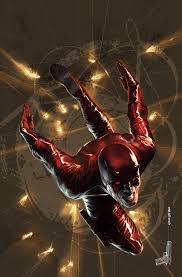 2000’s
2000’s
David Mack brought independent-comics colleague Brian Michael Bendis to Marvel to co-write the following arc, “Wake Up” in vol. 2 #16-19 (May 2001-Aug. 2001), which follows reporter Ben Urich as he investigates the aftereffects of a fight between Daredevil and the new Leap-Frog. Following Mack and Bendis were Back to the Future screenwriter Bob Gale and artists Phil Winslade and David Ross for the story “Playing to the Camera”. Mack continued to contribute covers.
The 2001 Daredevil: Yellow miniseries presented another take on Daredevil’s origins using letters written to Karen Page after her death. Here Page believes she is in love with both Daredevil and Murdock, and Nelson with Karen Page, resulting in a silent rivalry between the two men. The supervillains the Owl and the Purple Man are the antagonists. In this story, Daredevil credits Page with coining the phrase “The Man without Fear”, and she suggests to Daredevil he wear red instead of black and yellow.
Issue #26 (Dec. 2001) brought back Brian Michael Bendis, working this time with artist Alex Maleev. IGN called Bendis’ four-year-run “one of the greatest creative tenures in Marvel history” and commented that it rivaled Frank Miller‘s work. Developments in this run included the introduction of romantic interest and future wife Milla Donovan, the outing once again of Murdock’s secret identity, the reemergence of the Kingpin, and Daredevil’s surrender to the FBI.
The impact of his exposure as Daredevil continued to be used as a plot point by both Bendis and writer Ed Brubaker and artist Michael Lark, who became the new creative team with Daredevil vol. 2, #82 (Feb. 2006), no longer under the Marvel Knights imprint.
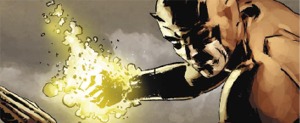 Danny Rand as Daredevil. Art by Michael Lark.
Danny Rand as Daredevil. Art by Michael Lark.
Brubaker’s first story arc had a new character masquerading as Daredevil in Hell’s Kitchen. Murdock later discovered the ersatz Daredevil is his friend Danny Rand, the superhero Iron Fist.
The series returned to its original numbering with issue #500 (Oct. 2009), which followed vol. 2, #119 (Aug. 2009). New writer Andy Diggle revised the status quo,
with Daredevil assuming leadership of the ninja army the Hand. Daredevil later appeared in the one-shot Dark Reign: The List – Daredevil.

